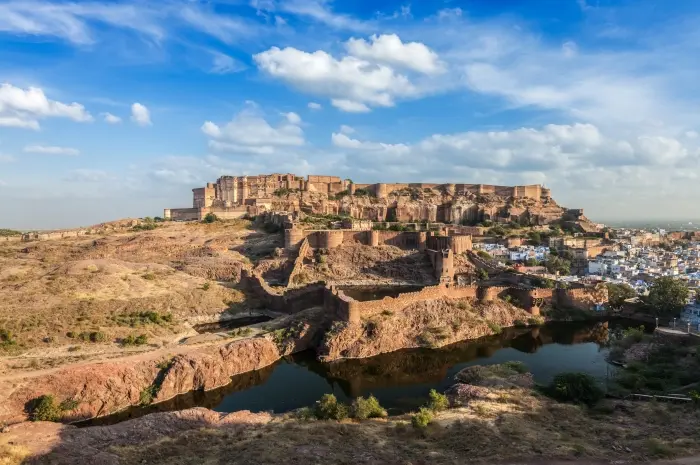Nestled atop a steep hill in the city of Jodhpur, Rajasthan, stands the magnificent Mehrangarh Fort, a testament to the rich heritage and architectural marvels of India.
This formidable fortress, with its massive walls and intricate detailing, has captivated the imagination of visitors for centuries.
In this article, we will delve into the history, reasons to visit, location and route, when to visit, and what to see at Mehrangarh Fort.
History
Mehrangarh Fort has a storied past that dates back to the 15th century when it was built by Rao Jodha, the founder of Jodhpur.
The fort, whose name translates to “Fort of the Sun,” was constructed as a protective stronghold for the ruling Rathore clan.
Over the centuries, subsequent rulers made additions and modifications, resulting in a complex and imposing structure.
The fort withstood several sieges and battles, reflecting the turbulent history of the region. The legendary tales of courage and valor associated with Mehrangarh Fort are etched in the annals of Indian history.
Its strategic location on a hill provided a vantage point for defense, making it an impregnable fortress against enemy forces.
Why Visit
Mehrangarh Fort beckons history enthusiasts, architecture aficionados, and curious travelers alike. Here are a few compelling reasons why you should visit this architectural marvel:
1. Historical Significance
The fort offers a glimpse into the glorious past of Rajasthan and its rich cultural heritage. Exploring its halls and courtyards is like stepping back in time, as you witness the remnants of battles, royal ceremonies, and opulent lifestyles.
2. Architectural Grandeur
The intricate detailing and imposing structure of Mehrangarh Fort are a sight to behold. The fort’s walls, adorned with exquisite carvings and latticework, showcase the mastery of Rajput architecture.
The ornate palaces, sprawling courtyards, and intricately designed windows provide a visual feast for visitors.
3. Museum and Collections
The fort houses a remarkable museum that displays an impressive collection of artifacts, weaponry, costumes, and art from different periods of history.
The museum offers insights into the royal heritage of Jodhpur and provides a deeper understanding of the region’s cultural heritage.
4. Panoramic Views
From the fort’s elevated location, visitors are treated to breathtaking panoramic views of the “Blue City” of Jodhpur and the surrounding landscape. The sweeping vistas are particularly captivating during sunrise and sunset.
Location and Route
Mehrangarh Fort is situated in Jodhpur, the second-largest city in the state of Rajasthan, India. The fort’s location on a hill called Bhaurcheeria (Bird’s Hill) offers a commanding view of the city below.
Jodhpur is well-connected by air, rail, and road networks. The city has its own airport, the Jodhpur Airport, which receives regular domestic flights from major Indian cities. The Jodhpur Railway Station is also well-connected to various cities across the country.
Once in Jodhpur, Mehrangarh Fort is easily accessible by road. Taxis, auto-rickshaws, and local buses are available for transportation to the fort.
It is advisable to check with local authorities or tourist information centers for the most convenient route based on your location in the city.
When to Visit
The best time to visit Mehrangarh Fort is during the winter months, from October to March, when the weather is pleasant and comfortable.
The scorching summer months, from April to June, can be quite hot and may hinder your exploration of the fort. Additionally, visiting early in the morning or late in the afternoon allows you to enjoy the fort without the intense heat and crowds.
What to See
Mehrangarh Fort offers a plethora of attractions to explore within its vast complex. Here are some key highlights:
1. Palaces
The fort boasts a series of intricately designed palaces, including Moti Mahal (Pearl Palace), Phool Mahal (Flower Palace), Sheesh Mahal (Mirror Palace), and Zenana Deodi (Ladies’ Chamber).
These palaces exhibit a fusion of Rajput and Mughal architectural styles, with delicate carvings, ornate ceilings, and beautiful frescoes.
2. Museum
The Mehrangarh Museum houses an extensive collection of artifacts, including arms, armor, textiles, paintings, and royal memorabilia.
The museum provides fascinating insights into the history, culture, and lifestyle of the Rathore rulers.
3. Chamunda Mataji Temple
Located within the fort complex, this ancient temple dedicated to the Goddess Chamunda is revered by locals and visitors alike. The temple’s vibrant ambiance and religious significance make it a must-visit attraction.
4. The Fort Walls and Gates
The massive fort walls, which stretch over 5 kilometers, are an architectural marvel in themselves. The seven imposing gates, such as Jai Pol and Fateh Pol, showcase intricate carvings and serve as a testament to the fort’s defensive capabilities.
5. Rajputana Architecture
The architectural elements found throughout Mehrangarh Fort, including its intricate jharokhas (balconies), chhatris (domed pavilions), and latticed windows, highlight the exquisite craftsmanship of the Rajputana era.
Visiting Mehrangarh Fort is a truly enriching experience that offers a glimpse into Rajasthan’s regal past and architectural brilliance.
Its historical significance, breathtaking views, and splendid architecture make it a must-visit destination for travelers seeking an immersive cultural experience.
